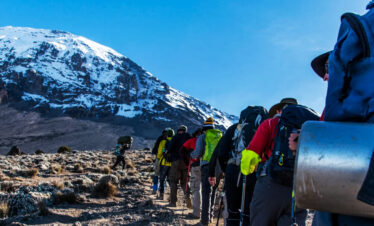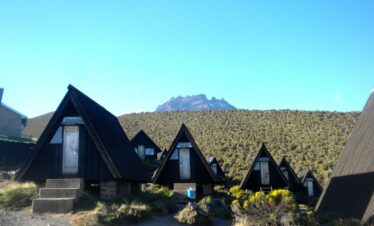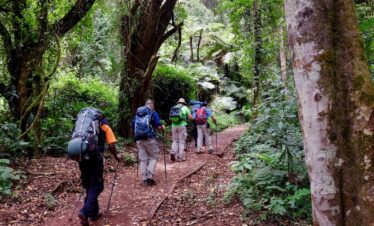Mt. Kilimanjaro Routes – Overview
Advantages and Disadvantage of All Mount Kilimanjaro Climbing Routes
Choosing the right Kilimanjaro route for your climb is an important decision.
There are eight main Mount Kilimanjaro routes: seven routes up Kilimanjaro and two down.
(Yes, that sounds like there are nine routes. But one of the ascent routes can also be used for descent, so there are in fact only eight routes.)
Several of these trails meet after a few days climbing and share the same path over the last days.
As a result, there are only three dedicated routes from the base of Kibo—the main peak—to the Kilimanjaro crater rim.
(One of them, the Western Breach route, is challenging, dangerous, and not used much. Which leaves only two.)
The routes to climb Kilimanjaro approach the mountain from different sides and they vary considerably in length, difficulty, traffic levels and other aspects.
Below you find an overview of those aspects for all eight Kilimanjaro routes.
Follow the links to find a detailed route description for each route or to see a picture guide of it.
(Here is a more detailed discussion of how those Kilimanjaro climbing routes compare regarding difficulty ratings, quality of wilderness experience, prices and success rates.)
Advantages and Disadvantages of the Different Kilimanjaro Climb Routes
Marangu | Machame | Rongai | Shira | Lemosho | Northern Circuit | Umbwe | Mweka
Marangu Route
For many years Marangu used to be the most popular Kilimanjaro route. It has now been delegated to number two by the Machame route (see below).
Duration: 5 days, acclimatisation day can be added
Advantages:
- Low cost.
- Accommodation is in huts, no camping equipment needed.
- Supposedly the easiest route. (I beg to differ.)
Disadvantages:
- Lowest success rate. (See? Not that easy after all!)
- Very crowded.
- Camping is not allowed.
- The only route that uses the same way up and down.
Machame Route
The Machame route is one of the most scenic routes on Kilimanjaro. Once the budget operators discovered it, Machame quickly became the most popular Kilimanjaro route.
Duration: 6 or 7 days
Advantages:
- Relatively low cost.
- Very scenic.
- Higher success rate than Marangu.
Disadvantages:
- Higher level of difficulty.
- Very crowded.
Rongai Route
The Rongai route is the easiest route up Kilimanjaro. It has a reputation as a remote wilderness trail. Rongai is the only route to approach Kilimanjaro from the north.
Duration: 5 or 6 days
Advantages:
- The easiest Kilimanjaro route.
- One of the quieter routes on Kilimanjaro.
- Approaches the mountain from the driest side, best chances of good weather.
- Ascent and descent are on opposite sides, you see both sides of Kilimanjaro. (You descend on the Marangu route.)
Disadvantages:
- Higher cost due to additional travel to reach other side.
- Considered somewhat less scenic.
Shira Route
The route over the Shira Plateau has several possible variations.
Duration: 6 – 8 days
Advantages:
- Less crowded on the first days.
- Very scenic.
Disadvantages:
- Higher cost.
- Higher difficulty level.
- Meets the Machame trail, hence very busy on the later days.
Lemosho Route
Remote and beautiful, but long and expensive, this route also approaches Kilimanjaro across the Shira plateau.
Duration: 7 – 8 days
Advantages:
- Very scenic route.
- Very low number of climbers during the first days.
- Plenty of time for acclimatisation.
Disadvantages:
- High cost.
- Higher difficulty level.
- Meets the Machame and Shira trail, hence very crowded on the later days.
Northern Circuit Route
Even remoter and more beautiful, longer and more expensive than Lemosho. The Northern Circuit shares the first days with the Lemosho Route, then circles around the extremely remote northern slopes to join the Rongai Route for the approach to the summit. You descend on the southern side along the Mweka Route.
Duration: 9 days
Advantages:
- Most scenic and varied route of all. You get to see all four sides of Kilimanjaro.
- Very low number of climbers during the first days, then even fewer over the next few.
- The days at serious altitude are all spent on the drier side of the mountain.
- Plenty of time for acclimatisation hence the highest success rates.
Disadvantages:
- Very high cost.
- Spending so many days on the mountain can be draining if not used to hiking and camping out.
Umbwe Route
The steepest Kilimanjaro route. Steep with a big capital S.
Duration: 5 – 6 days.
This route is not used much. The Umbwe route is only suitable for people with mountain climbing experience and who are already well adapted to the altitude.
Mweka Route
This is not a climb route, it is only used for descent. You will follow it if climbing Kilimanjaro on the Machame, Shira, Lemosho, Northern Circuit or Umbwe routes.
As restricted as all of this sounds, there are possible variations. Some of the routes have alternate paths for some sections, you can combine different sections of different routes, and treks can be extended to include a night in the crater itself, as I describe here for the Western Breach Route. (Only recommended to very experienced and well-acclimatised climbers. This camp is extremely high.)
Theoretically you could also walk right around the base of Kibo, something I’d love to do.
If you want to experience something different from the offered standard Kilimanjaro routes you need to find an agency willing to organize it for you, you need a special permit from KINAPA, and you need to be rich. (Which is why I haven’t done any of that yet.)
Read a detailed discussion of how those Kilimanjaro climbing routes compare regarding difficulty ratings, quality of experience, prices, and success rates.
Overview: What it takes to climb Kilimanjaro
Do you need help with all this?
Would you like to contact a responsible and trustworthy tour operator with competitive prices?
Get some free, no obligations advice on route selection, duration and timing?
I regularly receive emails asking me if there is a tour operator I personally can recommend.
There is and you can contact my preferred operator through this page.



